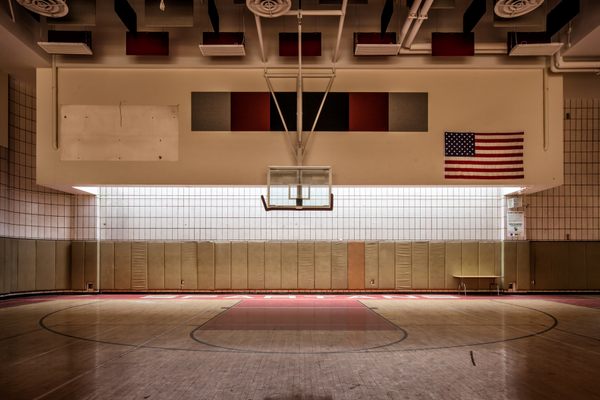Admiral’s Row: A Journey Inside the Regal Decay of Brooklyn’s Naval Past
Inside Admiral’s Row (all photographs by the author)
From splendor to squalor, Admiral’s Row has witnessed the changing Brooklyn waterfront for nearly 200 years, but perhaps nothing has changed so completely as Admiral’s Row itself. Admiral’s Row is a strip of land at the Brooklyn Navy Yard (once the neighborhood of Wallabout) which contains 10 Second Empire homes which housed navy officers from the 1850s to the 1970s.
Once worthy of the elite, today the buildings have fallen into such disrepair that most preservationists regard them as unsalvageable. “You wanta look around those old houses?” a Navy Yard worker responded when I asked if tours were offered of the fenced off buildings, “You’re pullin’ my leg, or you’re out of your mind”.
The state of the houses is beyond decrepit: it is apocalyptic; these buildings could not possibly be in worse condition without completely disintegrating. The walls are paper thin, the ceilings barely existent, and the floors so decayed every step you take leaves a deeper and deeper imprint until the ground caves completely, leaving a shoe-shaped window into the floor below.
There are some abandoned spaces which are scary for legal purposes, some which are scary because of physical danger, and some because of the eeriness of the space, and Admiral’s Row is all three. History is so thick in these homes that you can literally see the layers of time through the different stages of peeling walls. The fireplaces now covered in decades of dust are still ornate, albeit worthless but for their enlighteningly disremembered aesthetic. Piles of clothing on upper levels suggest generations of squatters, but the comforting presence of graffiti is strangely lacking. It’s as though only the elements could make their mark here.
The Brooklyn Navy Yard was established in 1801, authorized by President John Adams as one of the first five naval shipyards in America. The Navy Yard soon became a center for achievements not just in naval design, but medical as well, and even music. Creations ranging from anesthetic ether to ships with such notable accomplishments as laying the first undersea telegraph cable and sparking the Spanish-American War were born in the Yard, and the first song broadcast over wireless radio (“I Love You Truly”) was sent to the USS Dolphin, then docked at the Brooklyn Navy Yard.
By 1987 catastrophic job loss and closures of two major maritime tenants led the Yard to diversify its tenant base, so that by 2013 the largest yard expansion since WWII was underway, the 300 acre park now containing with 275 businesses, a movie studio, and a visitor center. The CitiBike prototypes were designed and tested in the Yard, and it street lamps are solar-powered and developed on-site.
As for the Admiral’s Row houses, they have a far more troubled, less rich history. Located on six acres of ground within the Brooklyn Navy Yard, Admiral’s Row also contains a timber shed (used for drying hardwood beams of tall masted sailing ships) built before the Civil War and considered to be the only remaining structure of its kind. Each house holds a wealth of memories of the lives lived there.
There’s Building D, built in 1951, likely by the designer of the US Capitol dome, Thomas Walter; and Building H, the only limestone of the bunch; as well as Quarters B, home of the yard commander Commodore Matthew C. Perry (who was credited with opening Japan to trade with the West) with its gardens and grand ballroom; and Building C, its mansard roof unrecognizable under all the ivy, and the rest, all doomed in their rickety glory.
Owned by the Army National Guard since the yard’s 1966 closure, the federal government did not officially transfer Admiral’s Row to the Brooklyn Navy Yard until January 27, 2012, by which point the houses were decades deep into governmental neglect. Even after the property had been transferred to the BNYDC (Brooklyn Navy Yard Development Corporation), work could not initially stabilize them because the National Guard deemed the structures so dangerous that workers may be endangered, meaning such elementary measures as boarding up broken doors and windows or throwing down tarpaulins to protect from rain could not take place for months.
Additionally, a historical and environmental review of the buildings ensured that their fate remained in perpetually disintegrating limbo. Alex Herrera, of the New York Landmarks Conservancy, went so far as to accuse the National Guard, in their inexplicable work restrictions, of “complete disrespect for Brooklyn and the naval and military history of the site.”
At the current point in the decay, only the timber shed and Quarters B (the largest building, and the one in best condition) are thought to be salvageable, which have the potential to be adapted and restored. Indeed, the city estimates that it would cost $20 million or more to rebuild the homes, and instead proposes they are demolished and a suburban style ShopRite with parking lot be put in their place.
Although the Landmarks Conservancy and Historic Districts Council have reacted with disgust to such a proposal, nearby residents of the Farragut houses received the plan warmly, as the area is poorly serviced and a major supermarket is badly needed.
Today the houses are considered to be awe-inspiring and eye sores, gems of the past that have decayed into the present and will likely vanish in the future. The 200-year-old care with which they were crafted lives on, only under layers and layers of dust. It is difficult to let go of such wonderful structures, even when I know a supermarket would be far more beneficial to the community. So crumble on, lovely buildings, it would seem that you are incapable of being beautiful, no matter what your state.
ADMIRAL’S ROW, Brooklyn, New York















Follow us on Twitter to get the latest on the world's hidden wonders.
Like us on Facebook to get the latest on the world's hidden wonders.
Follow us on Twitter Like us on Facebook